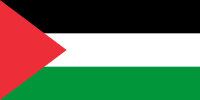 The Palestinian flag | |
| Total population | |
|---|---|
| ~500,000 (~6.5% of the global Palestinian population) (1990s–2000s estimate) | |
| Regions with significant populations | |
| |
| Languages | |
| Palestinian Arabic |
| Part of a series on |
| Palestinians |
|---|
 |
| Demographics |
| Politics |
|
| Religion / religious sites |
| Culture |
| List of Palestinians |
Palestinian Christians (Arabic: مَسِيحِيُّون فِلَسْطِينِيُّون Masīḥiyyūn Filasṭīniyyūn) are a religious community of the Palestinian people consisting of those who identify as Christians, including those who are cultural Christians in addition to those who actively adhere to Christianity. They are a religious minority within the State of Palestine and within Israel, as well as within the Palestinian diaspora. Applying the broader definition, which groups together individuals with full or partial Palestinian Christian ancestry, the term was applied to an estimated 500,000 people globally in the year 2000.[1] As most Palestinians are Arabs, the overwhelming majority of Palestinian Christians also identify as Arab Christians.
Palestinian Christians belong to one of a number of Christian denominations, including Eastern Orthodoxy, Oriental Orthodoxy, Catholicism (both the Latin Church and the Eastern-Rite Churches), and Protestantism (Anglicanism, Lutheranism, etc.), among others. In the 1990s, an estimate by Professor Bernard Sabella of Bethlehem University postulated that approximately 6.5% of the global Palestinian population was Christian, and that 56% of this figure was living outside of Palestine and Israel.[2]

As of 2015[update], Palestinian Christians comprise between 1% and 2.5% of the population of the West Bank, and about 3,000 (0.13%) of the population of the Gaza Strip.[3][4] According to official British Mandate statistics, Christians accounted for 9.5% of the total population (and 10.8% of Palestine's Arabs) in 1922 and 7.9% of the total population in 1946.[5] Over the course of the 1947–1949 Palestine war between the Palestinian Arabs and the Palestinian Jews, a large number of these Christians—as part of the Arab community—fled or were expelled by Jewish militias from what would become recognized as Israeli territory following the 1949 Armistice Agreements. Since the 1967 Arab–Israeli War, which resulted in Israel's occupation of the Palestinian territories (the Jordanian-annexed West Bank and the Egyptian-occupied Gaza Strip), the Palestinian Christian population has increased as a whole, but has decreased as a percentage of the total Palestinian population.[6]
Many individuals of the Palestinian diaspora who identify as Christians are descendants of the post-1948 Palestinian Christian refugees who fled from the Arab–Israeli conflict and settled in Christian-majority countries.[7][8]
- ^ Farsoun, Samih (2004). Culture and Customs of the Palestinians.
- ^ Bernard Sabella. "Palestinian Christians: Challenges and Hopes". Bethlehem University. Archived from the original on 15 April 2010. Retrieved 25 April 2004.
- ^ "The World Factbook". Archived from the original on 22 July 2021. Retrieved 21 January 2016.
- ^ IMEU. "Palestinian Christians in the Holy Land". Archived from the original on 4 January 2016. Retrieved 21 January 2016.
- ^ "Report to the League of Nations on Palestine and Transjordan, 1937". British Government. 1937. Archived from the original on 23 September 2013. Retrieved 14 July 2013.
- ^ Jewish Council for Public Affairs. "JCPA Background Paper on Palestinian Christians" (PDF). Archived from the original (PDF) on 11 July 2012. Retrieved 23 July 2013.
- ^ Chronicles – Volume 26. Rockford Institute. 2002. p. 7.
- ^ The Palestinian Diaspora, p. 43, Helena Lindholm Schulz, 2005